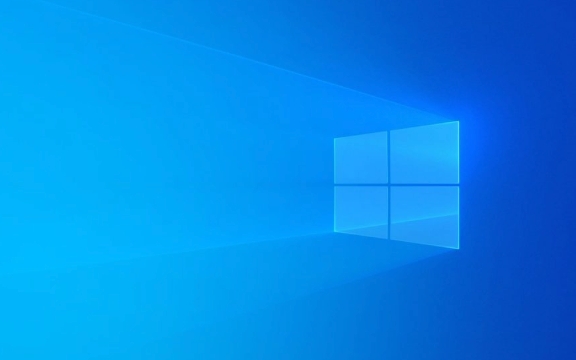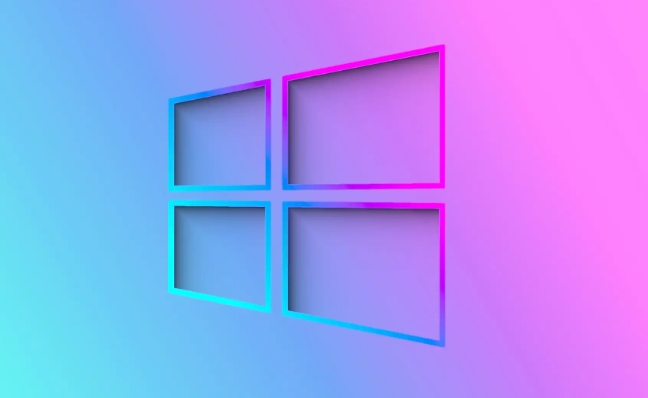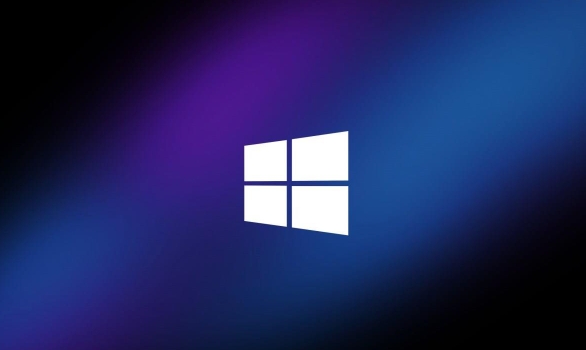When HDMI audio cannot work, first check the basic settings: make sure that the HDMI cable is connected normally, the monitor input source is correct, and manually select the correct playback device in Windows; secondly make sure that the HDMI audio device is not disabled, which can be enabled through the sound settings; then update or reinstall the audio driver, which can be operated in Device Manager; then run Windows Audio Troubleshooting; finally check the graphics card settings, such as the audio output options of NVIDIA or AMD. Checking one by one in order can solve most problems.

HDMI audio not working in Windows is a common issue, especially after updates or driver changes. The problem usually lies somewhere between your display settings, audio drivers, or device configuration. Here's how to troubleshoot and get sound back through HDMI.

Check the Basics First
Before diving into advanced fixes, make sure you've covered the basics:
- Is the HDMI cable properly connected?
- Is your monitor or TV set to the correct input source?
- Have you selected the right playback device in Windows?
To check the last point:

- Right-click the volume icon in the taskbar.
- Go to Sounds settings or Open Sound settings .
- Under Output , select the correct HDMI audio device from the list.
Sometimes Windows doesn't automatically switch audio output when you connect via HDMI — manually selecting it can fix the issue instantly.
Make Sure HDMI Audio Device Is Enabled
Windows might have disabled the HDMI audio device without notice.

Here's how to check:
- Press
Win R, typemmsys.cpl, and hit Enter. - In the Playback tab, look for devices like Digital Output (HDMI) or something similar.
- If you see it but it's grayed out, right-click and choose Enable .
- If there's no HDMI device listed, move on to checking drivers.
Also, some laptops have separate audio outputs for internal speakers and external displays — make sure the right one is active.
Update or Reinstall Audio Drivers
Outdated or corrupted audio drivers are often the root cause of HDMI audio issues.
Try these steps:
- Open Device Manager (
devmgmt.msc). - Expand Sound, video and game controllers .
- Right-click entries like High Definition Audio Device , Intel(R) Display Audio , or anything with “HDMI” in the name.
- Choose Update driver > Search automatically for updated driver software .
If that doesn't help:
- Uninstall the HDMI-related audio device(s).
- Restart your PC — Windows will reinstall them automatically.
Alternatively, download the latest audio drivers directly from your motherboard or laptop manufacturer's website for best compatibility.
Run the Windows Audio Troubleshooter
Windows includes built-in tools that can detect and fix common audio problems.
To use it:
- Go to Settings > System > Sound .
- Scroll down and click Troubleshoot under "Related settings".
- Let it run and apply any suggested fixes.
This won't always solve HDMI-specific issues, but it's worth trying before moving to manual fixes.
Check Your Graphics Driver Settings
Some graphics cards (especially NVIDIA and AMD) have separate audio components that need to be enabled.
For NVIDIA users:
- Open NVIDIA Control Panel .
- Go to Display > Set up digital audio .
- Make sure your display is selected and that Enable audio output is checked.
If you're using an AMD card, go into the AMD Catalyst Control Center or newer Radeon Software , and look for similar options under display or audio settings.
Fixing HDMI audio issues in Windows usually come down to ensuring the right device is selected, updating drivers, and checking hardware connections. Most of the time, it's not complicated — just a matter of going through each step carefully.
The above is the detailed content of How to fix HDMI audio not working in Windows?. For more information, please follow other related articles on the PHP Chinese website!

Hot AI Tools

Undress AI Tool
Undress images for free

Undresser.AI Undress
AI-powered app for creating realistic nude photos

AI Clothes Remover
Online AI tool for removing clothes from photos.

Clothoff.io
AI clothes remover

Video Face Swap
Swap faces in any video effortlessly with our completely free AI face swap tool!

Hot Article

Hot Tools

Notepad++7.3.1
Easy-to-use and free code editor

SublimeText3 Chinese version
Chinese version, very easy to use

Zend Studio 13.0.1
Powerful PHP integrated development environment

Dreamweaver CS6
Visual web development tools

SublimeText3 Mac version
God-level code editing software (SublimeText3)
 Windows Security is blank or not showing options
Jul 07, 2025 am 02:40 AM
Windows Security is blank or not showing options
Jul 07, 2025 am 02:40 AM
When the Windows Security Center is blank or the function is missing, you can follow the following steps to check: 1. Confirm whether the system version supports full functions, some functions of the Home Edition are limited, and the Professional Edition and above are more complete; 2. Restart the SecurityHealthService service to ensure that its startup type is set to automatic; 3. Check and uninstall third-party security software that may conflict; 4. Run the sfc/scannow and DISM commands to repair system files; 5. Try to reset or reinstall the Windows Security Center application, and contact Microsoft support if necessary.
 Windows stuck on 'undoing changes made to your computer'
Jul 05, 2025 am 02:51 AM
Windows stuck on 'undoing changes made to your computer'
Jul 05, 2025 am 02:51 AM
The computer is stuck in the "Undo Changes made to the computer" interface, which is a common problem after the Windows update fails. It is usually caused by the stuck rollback process and cannot enter the system normally. 1. First of all, you should wait patiently for a long enough time, especially after restarting, it may take more than 30 minutes to complete the rollback, and observe the hard disk light to determine whether it is still running. 2. If there is no progress for a long time, you can force shut down and enter the recovery environment (WinRE) multiple times, and try to start repair or system restore. 3. After entering safe mode, you can uninstall the most recent update records through the control panel. 4. Use the command prompt to execute the bootrec command in the recovery environment to repair the boot file, or run sfc/scannow to check the system file. 5. The last method is to use the "Reset this computer" function
 Proven Ways for Microsoft Teams Error 657rx in Windows 11/10
Jul 07, 2025 pm 12:25 PM
Proven Ways for Microsoft Teams Error 657rx in Windows 11/10
Jul 07, 2025 pm 12:25 PM
Encountering something went wrong 657rx can be frustrating when you log in to Microsoft Teams or Outlook. In this article on MiniTool, we will explore how to fix the Outlook/Microsoft Teams error 657rx so you can get your workflow back on track.Quick
 The RPC server is unavailable Windows
Jul 06, 2025 am 12:07 AM
The RPC server is unavailable Windows
Jul 06, 2025 am 12:07 AM
When encountering the "RPCserverisunavailable" problem, first confirm whether it is a local service exception or a network configuration problem. 1. Check and start the RPC service to ensure that its startup type is automatic. If it cannot be started, check the event log; 2. Check the network connection and firewall settings, test the firewall to turn off the firewall, check DNS resolution and network connectivity; 3. Run the sfc/scannow and DISM commands to repair the system files; 4. Check the group policy and domain controller status in the domain environment, and contact the IT department to assist in the processing. Gradually check it in sequence to locate and solve the problem.
 the default gateway is not available Windows
Jul 08, 2025 am 02:21 AM
the default gateway is not available Windows
Jul 08, 2025 am 02:21 AM
When you encounter the "DefaultGatewayisNotAvailable" prompt, it means that the computer cannot connect to the router or does not obtain the network address correctly. 1. First, restart the router and computer, wait for the router to fully start before trying to connect; 2. Check whether the IP address is set to automatically obtain, enter the network attribute to ensure that "Automatically obtain IP address" and "Automatically obtain DNS server address" are selected; 3. Run ipconfig/release and ipconfig/renew through the command prompt to release and re-acquire the IP address, and execute the netsh command to reset the network components if necessary; 4. Check the wireless network card driver, update or reinstall the driver to ensure that it works normally.
 How to fix 'SYSTEM_SERVICE_EXCEPTION' stop code in Windows
Jul 09, 2025 am 02:56 AM
How to fix 'SYSTEM_SERVICE_EXCEPTION' stop code in Windows
Jul 09, 2025 am 02:56 AM
When encountering the "SYSTEM_SERVICE_EXCEPTION" blue screen error, you do not need to reinstall the system or replace the hardware immediately. You can follow the following steps to check: 1. Update or roll back hardware drivers such as graphics cards, especially recently updated drivers; 2. Uninstall third-party antivirus software or system tools, and use WindowsDefender or well-known brand products to replace them; 3. Run sfc/scannow and DISM commands as administrator to repair system files; 4. Check memory problems, restore the default frequency and re-plug and unplug the memory stick, and use Windows memory diagnostic tools to detect. In most cases, the driver and software problems can be solved first.
 Windows 11 KB5062660 24H2 out with features, direct download links for offline installer (.msu)
Jul 23, 2025 am 09:43 AM
Windows 11 KB5062660 24H2 out with features, direct download links for offline installer (.msu)
Jul 23, 2025 am 09:43 AM
Windows 11 KB5062660 is now rolling out as an optional update for Windows 11 24H2 with a few new features, including Recall AI in Europe. This patch is available via Windows Update, but Microsoft has also posted direct download l
 How to repair Windows 11 using command prompt
Jul 05, 2025 am 02:59 AM
How to repair Windows 11 using command prompt
Jul 05, 2025 am 02:59 AM
How to use command prompt to repair Windows 11? 1. Enter the command prompt through the recovery environment: enter the recovery environment through USB boot or three consecutive interrupts, and then select Troubleshooting > Advanced Options > Command Prompt; 2. Use DISM to repair the system image: Run DISM/Online/Cleanup-Image/CheckHealth to check for corruption, DISM/Online/Cleanup-Image/ScanHealth scanning problem, DISM/Online/Cleanup-Image/RestoreHealth to repair the problem, and specify an external source if necessary; 3. Run SF






